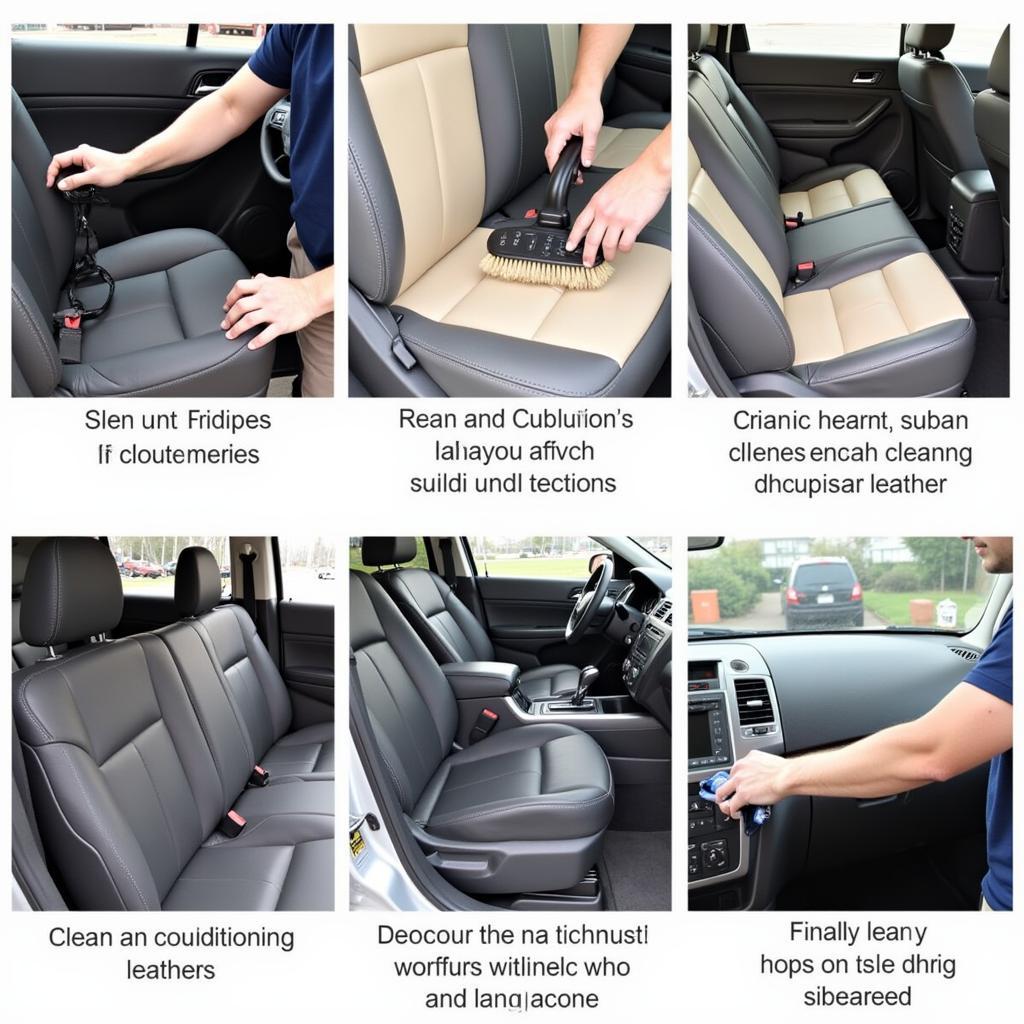Detailing your car is more than just a wash and wax. It’s a meticulous process that cleans, restores, and protects your vehicle inside and out, leaving it looking showroom-ready. Whether you’re a seasoned car enthusiast or a first-time detailer, this guide will provide you with the knowledge and techniques to achieve professional-level results.
Understanding the Importance of Car Detailing
Why bother detailing your car? Besides the obvious aesthetic benefits, regular detailing can significantly increase your car’s resale value. It also protects your paint from environmental damage, such as UV rays, acid rain, and bird droppings. A well-maintained car simply lasts longer and performs better.
Exterior Detailing: A Step-by-Step Process
Exterior detailing involves cleaning, correcting, and protecting the outside of your vehicle. This includes the paint, wheels, tires, trim, and glass.
- Pre-Wash: Rinse your car thoroughly to remove loose dirt and debris. This crucial step prevents scratching during the wash process.
- Wash: Use a high-quality car wash soap and a microfiber wash mitt. Work in sections, rinsing your mitt frequently. The two-bucket method is highly recommended – one with soapy water and one with clean rinse water – to minimize swirl marks.
- Decontamination: This step removes embedded contaminants like iron particles and tree sap that washing alone can’t tackle. Use a dedicated iron remover and a clay bar or mitt.
- Polishing (Optional): If your paint has swirl marks or minor scratches, polishing can restore its clarity and shine. This is best done with a dual-action polisher and appropriate polishing compound.
- Protection: Applying a sealant or wax creates a protective layer against environmental damage and enhances the shine of your paint. Sealants typically last longer than waxes.
- Wheels and Tires: Clean your wheels with a dedicated wheel cleaner and a soft brush. Dress your tires with a tire shine for a finished look.
- Glass: Clean your windows and mirrors with a dedicated glass cleaner and a microfiber towel.
Interior Detailing: Creating a Pristine Cabin
Interior detailing focuses on cleaning and protecting the inside of your car, creating a comfortable and inviting space.
- Vacuuming: Thoroughly vacuum the carpets, seats, and floor mats to remove dirt, dust, and debris. Use various attachments to reach tight spaces.
- Cleaning Upholstery: Use appropriate cleaners for your upholstery type (cloth, leather, or vinyl) to remove stains and refresh the fabric.
- Cleaning and Conditioning Leather: Leather requires special care to prevent drying and cracking. Use a leather cleaner and conditioner to maintain its suppleness.
- Cleaning Interior Surfaces: Clean all interior surfaces, including the dashboard, door panels, and center console, with a dedicated interior cleaner.
- Protecting Interior Surfaces: Apply a protectant to interior surfaces to prevent fading and cracking caused by UV exposure.
- Glass Cleaning: Clean the interior glass with a dedicated glass cleaner and a microfiber towel.
 Car Interior Detailing Steps in Progress
Car Interior Detailing Steps in Progress
Choosing the Right Products: The Key to Success
Using the correct products is crucial for achieving professional detailing results and preventing damage to your car. Opt for high-quality car wash soaps, microfiber towels, and dedicated cleaners for different surfaces. Avoid using household cleaners, as they can strip away protective coatings and damage your car’s finish.
“Investing in quality detailing products is an investment in your car’s long-term health and appearance,” says renowned detailing expert, Mark Williams. “Using the wrong products can do more harm than good.”
How to Detail Your Car Like a Pro on a Budget
Professional detailing can be expensive, but you can achieve excellent results at home with the right techniques and affordable products. Start with the basics and gradually add more advanced steps as you gain experience.
Common Car Detailing Mistakes to Avoid
Even with the best intentions, common mistakes can hinder your detailing efforts. Avoid using abrasive cloths or sponges, as they can scratch your paint. Don’t wash your car in direct sunlight, as it can cause water spots. And always use the proper dilution ratios for your cleaning products.
“One of the most common mistakes I see is people using too much product,” explains detailing specialist, Sarah Johnson. “Less is more when it comes to car detailing.”
Conclusion
Knowing how to detail your car is a valuable skill that can save you money and keep your vehicle looking its best. By following the steps outlined in this guide and investing in quality products, you can achieve professional-level results at home. Regular detailing not only enhances your car’s appearance but also protects its value and extends its lifespan. So, grab your detailing supplies and transform your car from ordinary to extraordinary.
FAQ
- How often should I detail my car? Ideally, every 3-6 months, depending on usage and environmental conditions.
- Can I detail my car in direct sunlight? No, it’s best to detail your car in the shade to prevent water spots.
- What type of wax should I use? The best wax depends on your car’s paint and your desired level of protection and shine.
- Do I need a machine polisher? A machine polisher is not essential for beginners but can be helpful for correcting paint imperfections.
- How can I remove stubborn stains from my upholstery? Use a dedicated upholstery cleaner and follow the manufacturer’s instructions.
- What is the best way to dry my car after washing? Use a high-quality microfiber drying towel to minimize scratching.
- How do I clean my car’s engine bay safely? Consult your car’s manual for specific instructions and use caution when cleaning around electrical components.
For further information, explore other articles on our website such as “Choosing the Right Car Detailing Products” and “Protecting Your Car’s Paint in Harsh Weather Conditions.”
Need help with your car detailing project? Contact us via WhatsApp: +1(641)206-8880, or Email: [email protected]. Our 24/7 customer support team is ready to assist you.

Leave a Reply